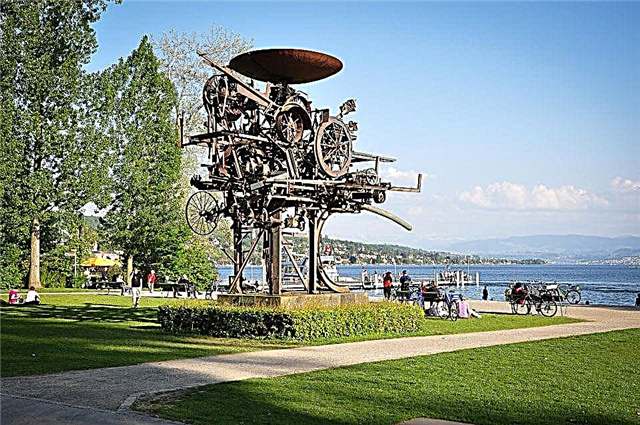Address: Russia, Nizhny Novgorod region, Nizhny Novgorod, Dobrolyubova street, 13A
Build date: 1649 year
Coordinates: 56 ° 19'27.6 "N 43 ° 59'42.3" E
Content:
The snow-white five-domed church appeared in the Nizhny Novgorod Verkhniy Posad in the middle of the 17th century. It became the first church in the history of Russian architecture built by a "ship". The altar, prayer hall, refectory building and a high bell tower that make up a single architectural ensemble are stretched here in one line - from east to west. In addition, the Znamensko-Myronositskaya Church is also the first Nizhny Novgorod temple, which was erected outside the fortress walls.

View of the church from Dobrolyubov street
Temple history
Before the appearance of the stone church, there was a wooden church on the Upper Posad. The first mention of it dates back to the XIII century. In church documents it is noted that the temple burned several times in fires and was especially badly damaged by fire in 1531. Then the church burned out almost to the ground, and they did not begin to restore it. 4 years later, a new two-story wooden church was erected on the ashes.
It is known that Christian ascetics revered by the faithful were born and baptized in the parish of the Znamensko-Myronositsky Church. In 1316, Saint Euthymius was born here, who later created the Savior-Euthymius monastery in Suzdal. In addition, Saint Macarius Zheltovodsky was born in the Upper Posad in 1349, who later founded several Orthodox monasteries.

View of the church from the side of the Lykova dam
At the beginning of the 17th century, after the heavy losses of the Time of Troubles, life in Russia began to recover. Trade was established, and in the second half of the 17th century, some cities became so rich that they began to carry out stone construction. And first of all, of course, they tried to rebuild Orthodox churches.
The priests who served there played an important role in replacing the wooden Church of the Sign of the Myrrh-Bearing Church with a stone one. They did not expect special favors and generous gifts from the authorities of Nizhny Novgorod, but acted like real entrepreneurs. From the surviving documents, it is known that Father Simeon signed a letter stating that he undertakes to pay to the patriarch's treasury an amount twice as large as in previous years. For these promises, he received permission from the church authorities and bought a profitable shop at the Nizhny Novgorod auction. In addition, this priest acquired profitable hay meadows beyond the Oka River. Father Simeon used the money received from the sale of goods and hay not only to pay off the patriarchal treasury, but also to start stone construction.

Church domes
The next priest of the Znamensko-Mironositsky Church, Father Mikhail, spent the funds accumulated by his predecessor on laying the foundation and purchasing the necessary building material. He also obtained a special diploma, which gave the parishioners the right to bring the brick necessary for construction from Balakhna and not pay a fee to the state treasury.
Znamensko-Myronositskaya Church became the first brick church built on the Nizhny Novgorod Verkhniy Posad (1649). Its lower floor was consecrated in honor of the Icon of Our Lady of the Sign. It was a winter temple where church services could be held during the cold season. And the upper floor was dedicated to the Holy Myrrh-Bearing Women and began to be used as a summer church.

View of the south facade of the church
In 1805, a wealthy merchant Peter Perepletchikov allocated money, and a two-story brick side-altar was added to the temple refectory. In the middle of the 19th century, the old wall paintings were renovated. And in the 1890s, at the expense of funds raised by parishioners, church chapels were significantly expanded.
After the 1917 revolution, the bells were removed from the church bell tower. During the years of an active anti-religious campaign carried out by the Soviet government, the Church of the Sign of the Myrrh-Bearing Church was closed (1931). The church chapters were dismantled and the bell tower was destroyed to the ground. A branch of the Moscow Higher Engineering School was located inside the church, and later - technical schools, which trained builders and workers in light industry. This saved the old church, and it was not destroyed. In 1966, the Znamensko-Myronositsky Church was even recognized as a cultural monument, but they did not begin to restore it in those years.

View of the church bell tower
The believers returned to the temple in 1995, and then the first services began to be held there. The ancient church by this time was in a completely disastrous, dilapidated state. The restoration and restoration work took a long time. But by the beginning of 2007, the temple was restored to its original appearance. Old photographs of the Church of the Sign taken at the end of the 19th century by the famous Nizhny Novgorod photographer Maxim Petrovich Dmitriev became a great help for restorers and builders.
There is a tram ring not far from the temple. In order to protect the old stone building from possible negative consequences, in 2005 a part of the tramway laid here was replaced. New rails on a 200 m section were installed on a special vibration-insulating coating.

View of the western facade of the church
Architectural features of the church
The vaults of the first floor of the temple and the refectory are supported by two pillars. The second floor of the Church of the Sign of the Myrrh-Bearing is pillarless. An outboard porch leads out onto it, preserved as it was built in the 17th century. In contrast to this picturesque porch, most of the church elements have undergone significant changes over a long history.
When the temple first appeared, the domes of the onion five-domed were decorated with glazed green tiles. Over time, it was changed to a more practical iron coating. Today, the central head of the temple is gilded, while four others are painted blue and decorated with gold stars.
During several restorations, the narrow windows on the first and second floors were cut, and an extension was made to the altar. The tiered bell tower, recently restored, now has a faceted hipped roof.
Today, the ancient Znamensko-Myronositskaya Church has the status of a protected cultural heritage site. A monument to the saints revered by the citizens of Nizhny Novgorod is erected at its walls. The monument depicts the figures of the Monks Macarius Zheltovodsky and Euthymius of Suzdal, who are holding a large cross.

Monument to the Monks Macarius Zheltovodsky and Euthymius of Suzdal at the walls of the church
The current state of the temple and the visiting regime
Today the temple is active and open to everyone. Church services are held here every day at 8.30 and 16.00. A Sunday school has been created for the children of the parishioners.
4 thrones have been consecrated in the church, and patronal holidays are celebrated here on April 14, the second Sunday after Easter, July 12, August 8 and December 10. Particularly revered shrines of the church are particles of relics that belonged to St. Macarius Zheltovodsky, as well as Alexander, Martha and Elena Diveevsky.
How to get there
The church is located in the Nizhny Novgorod region of the city, at 13A on Dobrolyubov Street. The temple can be reached by tram (stop "Dobrolyubova Street").











